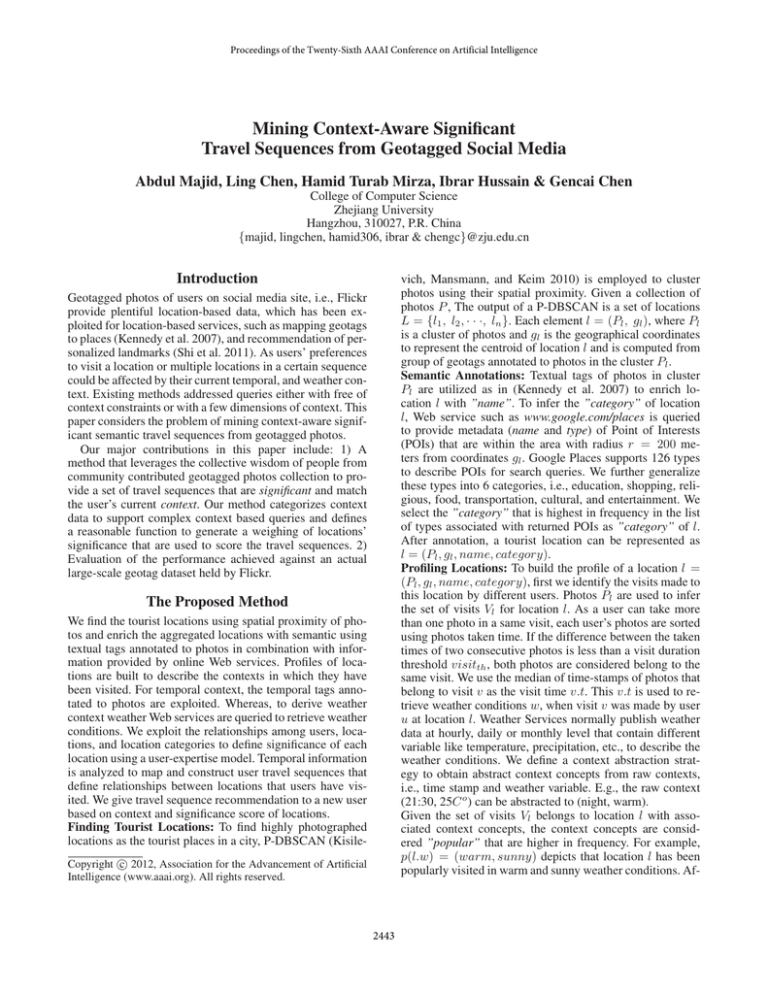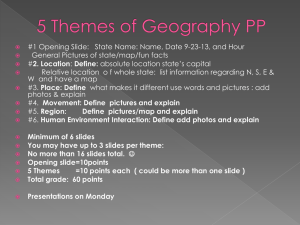
Proceedings of the Twenty-Sixth AAAI Conference on Artificial Intelligence
Mining Context-Aware Significant
Travel Sequences from Geotagged Social Media
Abdul Majid, Ling Chen, Hamid Turab Mirza, Ibrar Hussain & Gencai Chen
College of Computer Science
Zhejiang University
Hangzhou, 310027, P.R. China
{majid, lingchen, hamid306, ibrar & chengc}@zju.edu.cn
Introduction
vich, Mansmann, and Keim 2010) is employed to cluster
photos using their spatial proximity. Given a collection of
photos P , The output of a P-DBSCAN is a set of locations
L = {l1 , l2 , · · ·, ln }. Each element l = (Pl , gl ), where Pl
is a cluster of photos and gl is the geographical coordinates
to represent the centroid of location l and is computed from
group of geotags annotated to photos in the cluster Pl .
Semantic Annotations: Textual tags of photos in cluster
Pl are utilized as in (Kennedy et al. 2007) to enrich location l with ”name”. To infer the ”category” of location
l, Web service such as www.google.com/places is queried
to provide metadata (name and type) of Point of Interests
(POIs) that are within the area with radius r = 200 meters from coordinates gl . Google Places supports 126 types
to describe POIs for search queries. We further generalize
these types into 6 categories, i.e., education, shopping, religious, food, transportation, cultural, and entertainment. We
select the ”category” that is highest in frequency in the list
of types associated with returned POIs as ”category” of l.
After annotation, a tourist location can be represented as
l = (Pl , gl , name, category).
Profiling Locations: To build the profile of a location l =
(Pl , gl , name, category), first we identify the visits made to
this location by different users. Photos Pl are used to infer
the set of visits Vl for location l. As a user can take more
than one photo in a same visit, each user’s photos are sorted
using photos taken time. If the difference between the taken
times of two consecutive photos is less than a visit duration
threshold visitth , both photos are considered belong to the
same visit. We use the median of time-stamps of photos that
belong to visit v as the visit time v.t. This v.t is used to retrieve weather conditions w, when visit v was made by user
u at location l. Weather Services normally publish weather
data at hourly, daily or monthly level that contain different
variable like temperature, precipitation, etc., to describe the
weather conditions. We define a context abstraction strategy to obtain abstract context concepts from raw contexts,
i.e., time stamp and weather variable. E.g., the raw context
(21:30, 25C o ) can be abstracted to (night, warm).
Given the set of visits Vl belongs to location l with associated context concepts, the context concepts are considered ”popular” that are higher in frequency. For example,
p(l.w) = (warm, sunny) depicts that location l has been
popularly visited in warm and sunny weather conditions. Af-
Geotagged photos of users on social media site, i.e., Flickr
provide plentiful location-based data, which has been exploited for location-based services, such as mapping geotags
to places (Kennedy et al. 2007), and recommendation of personalized landmarks (Shi et al. 2011). As users’ preferences
to visit a location or multiple locations in a certain sequence
could be affected by their current temporal, and weather context. Existing methods addressed queries either with free of
context constraints or with a few dimensions of context. This
paper considers the problem of mining context-aware significant semantic travel sequences from geotagged photos.
Our major contributions in this paper include: 1) A
method that leverages the collective wisdom of people from
community contributed geotagged photos collection to provide a set of travel sequences that are significant and match
the user’s current context. Our method categorizes context
data to support complex context based queries and defines
a reasonable function to generate a weighing of locations’
significance that are used to score the travel sequences. 2)
Evaluation of the performance achieved against an actual
large-scale geotag dataset held by Flickr.
The Proposed Method
We find the tourist locations using spatial proximity of photos and enrich the aggregated locations with semantic using
textual tags annotated to photos in combination with information provided by online Web services. Profiles of locations are built to describe the contexts in which they have
been visited. For temporal context, the temporal tags annotated to photos are exploited. Whereas, to derive weather
context weather Web services are queried to retrieve weather
conditions. We exploit the relationships among users, locations, and location categories to define significance of each
location using a user-expertise model. Temporal information
is analyzed to map and construct user travel sequences that
define relationships between locations that users have visited. We give travel sequence recommendation to a new user
based on context and significance score of locations.
Finding Tourist Locations: To find highly photographed
locations as the tourist places in a city, P-DBSCAN (Kisilec 2012, Association for the Advancement of Artificial
Copyright Intelligence (www.aaai.org). All rights reserved.
2443
ter building the profiles of all locations, we maintain a locations database LDB = {l1 , l2 , · · ·, ln }.
Finding Users’ Travel Sequences: A travel sequence s =
{l1 , l2 , ··, ln } can be taken as a trip made by a user to visit a
sequence of locations in a temporal order, i.e., li+1 .t > li .t,
where i = (1..n) represents the position of location in sequence s. To extract the travel sequences for each user: 1)
The time-stamps annotated to user’s contributed photos are
exploited to sort the photos in order to yield his/her traveling history; 2) We split travel history into travel sequences if
the difference in the time stamp of two consecutive photos
is greater than a given threshold tripdur ; 3) Each photo is
replaced with its corresponding tourist location from LDB.
If two consecutive photos represent the same location then
only one photo is taken into consideration. After the extraction of travel sequences for all users, we build a travel sequence database SDB = {S1 , S2 , ··, Sn } where Si represents the set of trips made by user i.
Building User-Location-Category Graph: We organize
three entities (users, locations, and location categories) and
relationships (visits) among these entities into a meaningful data structure, i.e., user-location-category tripartite graph
GU LC = (U ; L; C; EU L ; WU L ; EU C ; WU C ; ELC ), where
U , L and C are nodes to represent users, locations and location categories respectively. EU L and WU L are sets of edges
and edge weights between U and L to represent users’ visits and the number of visits to particular locations. EU C and
WU C are sets of edges and edge weights between U and C
to represent users’ visits and the number of visits to particular location categories. ELC are edges between L and C to
describe the categories of locations.
Mining Significance of Locations: Significance of locations is mined using a user-expertise model, i.e., generate
a weighing of location significance through the number of
user visits to specific location categories. (1) Given m users
and n categories, we build an m×n adjacency matrix MU C .
Each entry in MU C (p, q), depicts the experience of user up
in location category cq . (2) To capture the relationship between users and locations, given m users and k locations, a
m × k adjacency matrix MU L is built. So in matrix MU L ,
Ij = {i} where MU L (i, j) =
6 0, is the set of indices of users
who have visited location j. Significance score of each location lj (j = 1··k), which isPof location category cq (q = 1··n)
is computed by: g(lj ) = i∈Ij MU C (i, q).
Recommendations: Processing of context aware query
Q(t, w) made by user up proceeds as a two-step approach:
an initial filtering step retrieves travel sequences belong to
target city from SDB that meet the contextual constraints
given in the query, thus producing a filtered set of sequences
S 0 . In the second step: significance score for each travel sequence s ∈ S 0 is computed by aggregatingPthe significance
n
score of locations it contains as: r(s)) = n1 i=1 g(li ). Next
the travel sequences in S 0 are ranked using score r and top
k travel sequences are returned as query result.
Table 1: Performance Comparison
nDCG@5
nDCG@10
FrequentRank
0.713
0.735
ClassicRank
0.770
0.804
Our Method
0.853
0.892
in six different cities of China between January 2001 and
July 2011. Historical weather data of these cities was collected using public API of an online weather Web service
www.wunderground.com.
Baseline Methods: As baseline methods, we used (a)
Frequent-Rank (Yin et al. 2011), that employs PrefixSpan
(Pei et al. 2001) to extract frequent sequential patterns from
SDB whose frequencies are not smaller than the given minimum support threshold mins = 2 and (b) Classic-Rank, a
method as given in (Zheng et al. 2009) to score the travel sequences by exploiting reenforcement relationships between
users and locations from matrix MU L .
Results: A large quantity of user queries were simulated
with different contextual constraint settings. Four experts
(tour guides) who are well familiar with these cities were
requested to evaluate the output of our and baseline methods
and provide the feedback. They were asked to evaluate top
5 and top 10 travel sequences using three scores, i.e., Very
much interesting (3), interesting (2), neutral (1), not interesting (0). Table 1 depicts the effectiveness of our and baseline
methods in terms of normalized discounted cumulative gain
(nDCG@5 and nDCG@10). Results show that, as compared
to baseline methods, our approach made recommendations
that are more relevant (paired t-test with p < 0.05).
Acknowledgements
This work was funded by the Ministry of Industry and Information Technology of China (No.2010ZX01042-002-003001), Natural Science Foundation of China (No. 60703040),
and Science and Technology Department of Zhejiang
Province (Nos. 2007C13019, 2011C13042).
References
Kennedy, L.; Naaman, M.; Ahern, S.; Nair, R.; and Rattenbury, T. 2007. How flickr helps us make sense of the world:
context and content in community-contributed media collections. In Proc. of Multimedia’07, 631–640.
Kisilevich, S.; Mansmann, F.; and Keim, D. A. 2010. Pdbscan: a density based clustering algorithm for exploration
and analysis of attractive areas using collections of geotagged photos. In Proc. of COM.Geo.
Shi, Y.; Serdyukov, P.; Hanjalic, A.; and Larson, M. 2011.
Personalized landmark recommendation based on geotags
from photo sharing sites. In Proc. of ICWSM.
Yin, Z.; Cao, L.; Han, J.; Luo, J.; and Huang, T. S. 2011. Diversified trajectory pattern ranking in geo-tagged social media. In Proc. of SDM, 980–991.
Pei, J.; Han, J.; Mortazavi-Asl, B.; Pinto, H.; Chen, Q.; Dayal,
U.; and Hsu, M. 2001. Prefixspan: Mining sequential patterns
by prefix-projected growth. In Proc. of ICDE, 215–224.
Zheng, Y.; Zhang, L.; Xie, X.; and Ma, W.-Y. 2009. Mining
interesting locations and travel sequences from gps trajectories. In Proc. of WWW’09, 791–800.
Evaluation
Data Collection: Public API of Flickr (www.flickr.com) was
used to collect 736383 geotagged photos that were taken
2444



